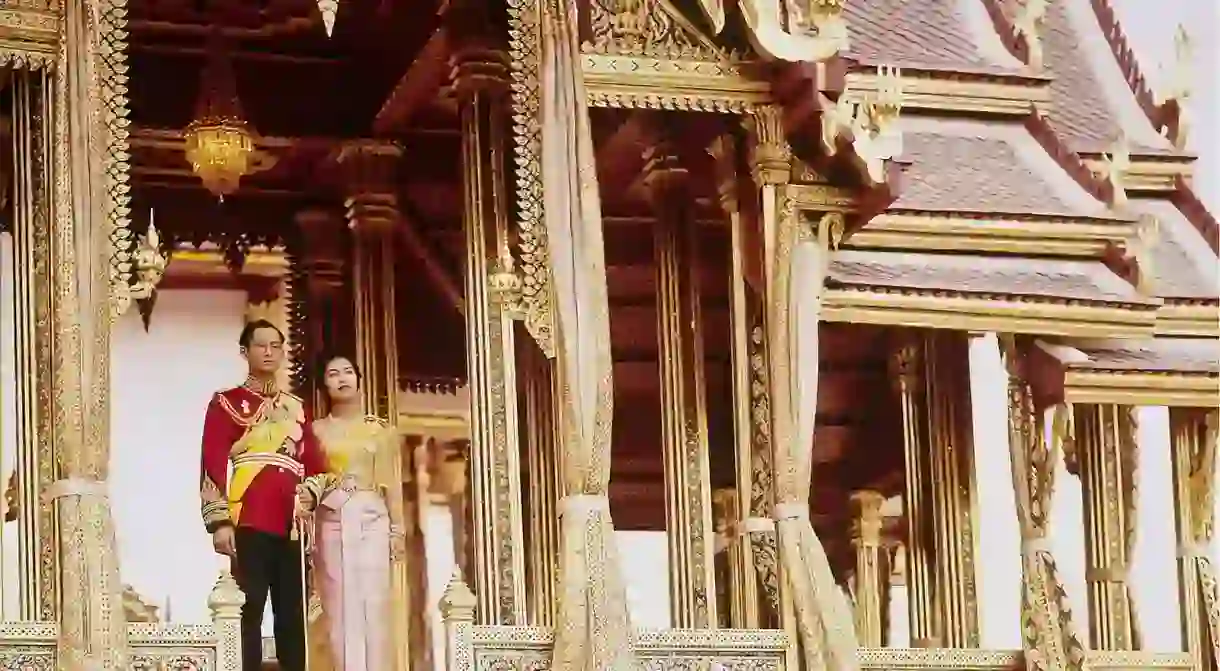Royal Wardrobe: How Thailand's Queen Made Politics High-Fashion

If you look at pictures of female members of the Thai Royal Family you’ll likely notice that they often wear similar attire. This is no coincidence; they will almost certainly be wearing one of the official outfits of chut thai phra ratcha niyom (Thai dress of royal endorsement). Read on to find out how these officially sanctioned outfits came into being.
European influences in Queen Sirikit’s early life
Born in 1932 to a Thai prince, Sirikit Kitiyakara is a descendant of King Chulalongkorn. Her father was a diplomat who was often posted overseas. She spent her early years living with her family in Bangkok during the First World War. When the war ended, Sirikit’s father took the family to live in the UK, where the teenage Sirikit became fluent in English and French, learned how to play the piano, and finished her education. The family travelled around various European countries and lived in places like Denmark and France.
While living in Paris, Sirikit Kitiyakara studied in a prestigious music academy. She socialised in political circles, largely because of her father’s work, and was a member of the upper class. She met Bhumibol Adulyadej in Paris too, accompanying the new Thai king on sightseeing trips. She then went to study in Lausanne, Switzerland, on the request of the king’s mother, close to where the king was also studying.

Moving more into the spotlight
The young Sirikit Kitiyakara and Bhumibol Adulyadej became engaged in 1949, marrying the following year in Bangkok. Their wedding took place just one week before the King’s coronation and the couple then returned to Switzerland to finish their studies.
She acted as the regent when the King entered the Buddhist monkhood for a period. Having completed the duties exceptionally well, she was named as the official Regent of Thailand (the person who performs the monarch’s duties in their absence), becoming only the second queen throughout Thailand’s history to have been given such an honour.

Clothing fit for royalty
Although Queen Sirikit always dressed elegantly, modestly, and stylishly, she quickly realised that Thailand didn’t actually have an official national outfit. There were various traditional items of clothing but no one outfit to represent Thailand at an international level. As a diplomat’s daughter and wife of the Thai King, no Thai woman would have felt under as much pressure to look good in public.
On visiting Europe and the USA alongside her husband on official duties, Queen Sirikit decided to tackle the clothing issue and design an official national outfit for women. Returning to Bangkok, she began researching Thai traditional clothing and what members of royalty had worn to official functions in the past. Overseeing a team of researchers and designers, the Queen then created eight outfits for official functions. Many outfits shared similarities, incorporating styles and fabrics that were already representative of the nation, but they varied in their degree of formality.
The Queen ensured there was attire to suit diverse functions, from semi-casual daytime events to the most formal of meetings and evening affairs. One outfit, known as dusit, draws on European fashion, combining Western and Thai styles. The sleeveless silk dress was almost likely a result of the Queen’s time spent socialising abroad.

The birth of Thai national dress
In 1964, the Thai national costume came into existence. It is known as chut Thai phra ratcha niyom, which means “Thai dress that has been royally endorsed”. The name is often shortened to chut Thai (Thai outfit) for simplicity.
The Queen and her design team then worked hard to promote the outfits, making them appeal to the public as well as to royalty. The Queen was, from that point on, always seen wearing chut Thai at important functions, including political and diplomatic meetings overseas and at home, royal parties, and public engagements.
Now, chut Thai is not only the official clothing of the female members of the Thai Royal Family, but it is also worn by performers in cultural shows and by members of the public for special events, including weddings and celebrations. Despite being a relatively new creation, tune into the popular Thai period drama called Love Destiny and you’ll see attractive Thai national dresses in all their glory.

Through her knowledge of Thai society and international relations, public exposure, position of power and respect, education, and love for Thai culture, Queen Sirikit gave Thailand beautiful and timeless fashion to be proud of.













